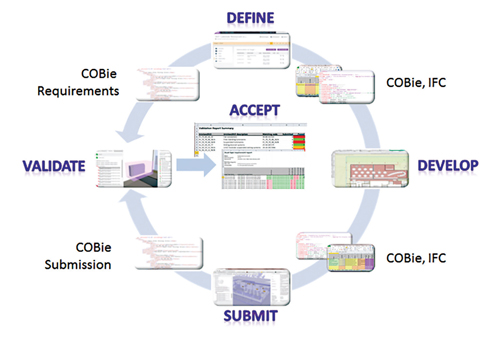Professor Steve Lockley, Research Director at BIM Academy and Professor of Building Modelling at Northumbria University, looks at considerations around validating employers’ information requirements.
In most data-centric industries, validation and/ or verification of information exchanged between collaborating parties are key factors in their contractual relationships. As the construction industry continues its transition from a craft-based industry to one which exploits advanced manufacturing techniques with digital design and engineering methodologies, the issue of data validation and verification becomes more and more important.
Over the last 500 years or so the industry has always adapted to using the latest information management techniques to convey design intent. This ranges from sophisticated physical models such as Gaudi’s model for Sagrada Familia (Figure 1), through CAD drawings to virtual reality models.

Figure 1: Tensile structural model, Sagrada Familia
However, over the last 40 years, the increased tendency to litigate for inadequate, late or incorrect information exchange between parties has driven professionals to regard information exchange as a liability and a part of their risk management procedures.
As the uptake of BIM begins to impact, leading-edge organisations have begun to understand the benefits and problems that BIM technologies add to this information exchange arena. Many have realised that exchanging native models can dramatically increase productivity and efficiency. Others have realised that these models may contain information they are completely unaware of, and that could cause claims to be brought against them. Indeed some organisations go so far as to develop processes that automate the removal of most data from their models, just in case it may lead to litigation problems.
We have now reached a point where if we are to move forward with BIM and the efficiencies it can bring, we need to have mechanisms to formalise the data exchanges between parties - before they happen and to check that they are acceptable - when they happen. On the validation and verification spectrum there are many levels, ranging from the most simplistic that can be automatically checked by a computer, to the most complex that can only be performed with human expertise and judgment. Ironically, the industry has started to engage at the high end of this spectrum with validation activities such as clash detection, rather than address much simpler activities such as robust data sharing re-use. For successful clash detection several parties must each submit their BIM content in a form that can be federated consistently so that clashes can be identified. Common causes of failure in federation can often be traced back to the lack of clear data contracts defining what data is shared and how it can be re-used; these contracts include specifications of how to define items such as grids, co-ordinate systems, locations, object names and classifications. In an ad-hoc manner these issues are being addressed by the industry through the development of BIM execution plans and undoubtedly custom and practice will develop over time to standardise these activities.
In parallel with these technology changes we also have construction clients or employers becoming far more engaged with their supply chain. They have information they wish to communicate and requirements for information they wish to receive back from the industry. Essentially they wish to procure, or buy, information as well as buildings from the supply chain so that they can better manage their total expenditure on capital assets.
In this first release, the NBS BIM Toolkit provides a mechanism to help employers specify ‘what’ information they want and to validate that this information has been supplied to them. This simple ‘presence’ form of validation is the keystone for future more sophisticated work, such as ‘range checking’ (the value within required bounds). It begins with the employer identifying the processes, assets, and systems they are concerned about when they begin a procurement project. It may be a consultation process, a space demand, a facility such as an operating theatre or a prison cell, or an operational matter such as maintenance frequency. The NBS BIM Toolkit provides a mechanism to easily capture these and formalise them in the COBie information structure, it also provides tools that check that the suppliers’ data submission contains the employer’s required information. The initial release does not check that the values of the data supplied meet the employer’s requirements. A simple example would be an employer commissioning a building that contains a gas boiler and requiring knowing the name of the boiler manufacturer and the model number. The validation in the NBS BIM Toolkit would examine the BIM and identify that a boiler had been provided and that a manufacturer name and model had been given.

Figure 2: Verification workflow
Figure 2 defines a typical workflow envisaged in the NBS BIM Toolkit. An employer defines what they want to receive as structured data; the delivery team develop a proposal and submit a BIM in industry open standards such as IFC or COBie. The NBS BIM Toolkit provides the tools to review the team’s submission identify where the client’s information requirements have, or have not, been met. If there are errors or omissions the NBS BIM Toolkit will identify these and allow the user to return to their BIM tool and correct them. This saves wasted time by avoiding the client receiving incorrect submissions.
To allow the NBS BIM Toolkit review process to be carried out in all types of organisation, both a ‘cloud’ version and a standalone ‘in-house’ version are available.
Once a submission is ready it is passed on to the validation tool which produces a simple spreadsheet report indicating the contents of the file and its compliance. Again this can be performed in-cloud or in-house.
A novel feature of the NBS BIM Toolkit is the ‘BIMogram’. This is the ability to see an employer’s requirements in 3D with all the required properties before the building has been given any geometric form, and this allows a quick thumbnail to be created giving an information signature for the requirements. The columns and different colours reflect different types of asset in the model.
All the software to perform validation and verification is free to use and built on the xBIM open source technology. It is envisaged that software vendors will utilise this codebase to integrate validation and submission into their commercial products.
For more details on the xBIM platform please visit www.OpenBIM.org ![]() , or for the source code visit the xBIMTeam at www.github.com/xBimTeam
, or for the source code visit the xBIMTeam at www.github.com/xBimTeam ![]() .
.
This article originally appeared in the NBS National BIM Report 2015 . Download your free copy of the full report containing specialist insight and analysis.
Related NBS Services
Develop specification information through the construction timeline with NBS Create. Our software allows you to create outline specifications, considering performance throughout, and then develop this through to a full specification.
The NBS BIM Toolkit allows collaborative project teams to define how much information is required and when it should be provided through the project timeline.
Create your first NBS BIM Toolkit project

